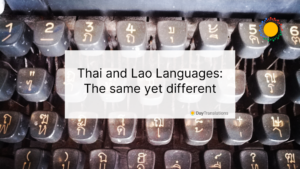Updated 2022
The relationship between language and culture is a complex one. The two are intertwined. A particular language usually points out to a specific group of people. When you interact with another language, it means that you are also interacting with the culture that speaks the language. You cannot understand one’s culture without accessing its language directly.
When you learn a new language, it not only involves learning its alphabet, the word arrangement and the rules of grammar, but also learning about the specific society’s customs and behavior. When learning or teaching a language, it is important that the culture where the language belongs be referenced, because language is very much ingrained in the culture.
Paralanguage: The Relationship Between Language and Culture
Complex is one term that you can use to describe human communication since paralanguage is used to transmit messages. Paralanguage is specific to a culture, therefore communication with other ethnic groups can lead to misunderstandings.
When you grow up in a specific society, it is inevitable to learn the glances, gestures, and little changes in voice or tone and other communication tools to emphasize or alter what you want to do or say. These specific communication techniques of one culture are learned mostly by imitating and observing people, initially from parents and immediate relatives and later from friends and people outside the close family circle.
Body language, which is also known as kinesics, is the most obvious type of paralanguage. These are the postures, expressions, and gestures used as non-verbal language. However, it is likewise possible to alter the meaning of various words by changing the character or tone of the voice.
Homologous Relationship Between Language and Culture
The phrase, language is culture and culture is language is often mentioned when language and culture are discussed. It’s because the two have a homologous although complex relationship. Language and culture developed together and influenced each other as they evolved. Using this context, Alfred L. Krober, a cultural anthropologist from the United States said that culture started when speech was available, and from that beginning, the enrichment of either one led the other to develop further.
If culture is a consequence of the interactions of humans, the acts of communication are their cultural manifestations within a specific community. Ferruccio Rossi-Landi, a philosopher from Italy whose work focused on philosophy, semiotics and linguistics said that a speech community is made up of all the messages that were exchanged with one another using a given language, which is understood by the entire society. Rossi-Landi further added that young children learn their language and culture from the society they were born in. In the process of learning, they develop their cognitive abilities as well.
According to Professor Michael Silverstein, who teaches psychology, linguistics and anthropology at the University of Chicago, culture’s communicative pressure represents aspects of reality as well as connects different contexts. It means that the use of symbols that represent events, identities, feelings and beliefs is also the method of bringing these things into the current context.
Influencing the Way People Think
The principle of linguistic relativity tells us that language directly influences the way people view the world. Anthropologist-linguist Edward Sapir of the United States said that the language habits of specific groups of people built the real world. He further added that no two languages are similar in such a way that they would represent one society. The world for each society is different. In analysis, this means that speaking a language means that the person is assuming a culture. Knowing another culture, based on this principle, is knowing its particular language. And we need communication to highlight interpretations and representations of that world. This is why the relationship between language and culture is essential when learning any new language.
Inter-Cultural Interactions
What is likely to happen if there is an interaction between two cultures? In today’s scenario, intercultural interactions are very common. Communication is necessary for any person who wants to understand and get along with people whose backgrounds and beliefs are greatly dissimilar from their own.
It is easy to use language to mark cultural identity. But we also use language to describe processes and developments, like explaining the intentions of a specific speaker. Specific languages refer to particular cultural groups.
Values, basic assumptions, behavioral conventions, beliefs, and attitudes shared by an ethnic group make up what we call culture. This set of attributes influences the behavior of the individual members of the group and their interpretations of the meanings of the behavior displayed by each member.
It is through language that we express the attributes of culture. We also use language to point out unique objects in our cultures.
All this means that learning and teaching another language is essential for international communication and cooperation. The knowledge of other languages facilitates knowledge of other countries and the specific cultures of each one. Again, this is why the relationship between language and culture is critically important.
Transmission of Culture and Language
Language is learned, which means it can be culturally transmitted. Pre-school children take on their first language from their exposure to random words they encounter in and out of their homes. When they reach school age, they learn their first language or another language. If it is the first language, the children are taught writing and reading, the correct ways to construct sentences, and how to use formal grammar. However, the child gained initial knowledge about the essential structure and vocabulary of the first language before the child started school.
Conversely, culture is transmitted in a large part, by language, through teaching. Language is the reason why humans have histories that animals do not have. In the study of animal behavior through the course of history, alterations to their behavior were the result of the intervention of humans through domestication and other types of interference.
The culture of humans on the other hand is as different as the world’s languages. They are likely to change over time. In industrialized countries, the changes in the language are more rapid.
Language Shapes Culture
Oral instruction, and not imitation, is how we learn the culture. There could be some imitation if the learner is still young. With language, we have a better way to understand methods of social control, products, techniques, and skills. Spoken language offers a vast quantity of usable information for the community. This helps to quicken new skill acquisition and the techniques to adapt to new environments or altered circumstances.
The advent of writing increased the process of cultural dissemination. Diffusing information became much easier thanks to the permanent state of writing. And thanks to the invention of printing and the increase in literacy, this process continues to evolve and speed up.
Modern techniques for fast communication transmission across the globe through broadcasting and the presence of translation services around the world help make usable knowledge to be accessible to people anywhere in the world. Thus, the world benefits from the fast transference, availability, and exchange of social, political, technological, and scientific knowledge.
Assimilation and Social Differentiation, and Language
Through time, variations appeared within a language. Transmission of a language is self-perpetuating unless there is deliberate interference. However, it became important for humans to improve their social hierarchies and social status to advance personally. It’s safe to say that many people cultivate their dialect phonologically, grammatically, and lexically to fit into new communities.
An example of this phenomenon is the insistence of immigrants from Europe to speak American English when they decided to move to the United States. It is because they realized that speaking American English is a sign of acceptance in their new home country. Unexpectedly, third-generation immigrants now want to get in touch with the language of their ancestors.
Cultural and Linguistic Diversity
Culture unifies a community although there is diversity within that unity. For example, the older generation’s speech might differ from the speech younger people use. Also, different groups speak different languages. This is evident in the differences present in a professor’s speech compared to a young admin staff member at the university. People could use a different form of the same language in online forums, which would vastly differ from the language used by media and classically trained individuals.
We use language in different ways. Linguistic varieties fall into geographical, social, and functional subclasses. These factors lead to the formation of dialects that add diversity to the language.
At Day Translations, Inc., our translators are not only linguistic experts. Because they are native speakers, each of them understands their own culture like the backs of their hands. They inherently understand the nuances of their language as well as the languages they work with. They apply their deep cultural knowledge to the translation projects they handle because they have a deep understanding of the relationship between language and culture.
Get in touch with our translators day or night, wherever you are. We are open 24/7, all days of the year, to provide you with professional translation service with the highest level of quality and accuracy. For an instant translation quote, send us an email at Contact us or call us at 1-800-969-6853.














Sorry, the comment form is closed at this time.